Last year, right around this same season, I spent several days over several weeks shuttling back and forth to Nueva Pompeya, a barrio on the southwest side of Buenos Aires, checking out a stretch of Peruvian restaurants along Av. Saenz that had caught my attention. I noted that there were more spots, both along the avenue and on side streets, that I hadn’t gotten to, and more or less implied that one day I’d give those a go too. I started with my same premise, at each place get the soup of the day and whatever my waiter considered either the house specialty or the most popular dish, or simply their personal recommendation. That part didn’t go as well this time around.
Let’s start here, because it hearkens back to last year’s ventures. La Perla, Av. Saenz 575, is in the spot that last year was Juanita y Paul. Although the storefront has been majorly redone, inside it looked… pretty much identical, in fact, the old Juanita y Paul signage is still emblazoned in front of the kitchen. And the menu looks suspiciously like they just put a new cover page on it. But no, my waiter assures me, this is La Perla now. Only, later, after eating, when I’m paying at the register, talking to the manager, do I find out that it’s still Juanita y Paul who both own the place and are right there in the kitchen cooking. It’s just a name change, nothing more. And, by the way, they opened a second location right up the block, called Tiburón II y Juanita – why Paul has been replaced by a second generation shark, I don’t yet know.
As I’ve mentioned recently, I’m trying to eat less, and am steadily losing weight. So, having glanced around the room and seen that the soup of the day looked like a rather uninteresting noodle and beef version, I decide to just go with the waiter’s recommended plate. He asserts that pollo a las brasas is without a doubt their top plate (and that was the recommended plate last year too, by a different server). However, they didn’t have any. His personal favorite was pique a lo macho, but that’s an inexcusable affront to all things culinary, and is Bolivian not Peruvian besides.
[Pique a lo macho is a heaping platter of french fries tossed with bite sized pieces of stewed beef, chopped up hot-dogs and hard boiled eggs, onions and peppers. It’s something that looks to have been thrown together by a stoned cook after a really hard night. The legend is that the Pique Macho or Pique a lo Macho was created by Honorato & Evangelina Quinones, owners of Restaurante Miraflores in Cochabamba, Bolivia. Supposedly, a group of workers, late at night, drunk, were hungry. The owners said they were closing and had nothing really available. The group of workers insisted that they would eat anything. Evangelina proceeded to chop what she had left of the ingredients left in the kitchen and served them really spicy to help with their drunkenness. She then said “Piquen si son machos”, “Eat it if you think you’re man enough”, and that is how it got its name.
It’s also not perking up my interest that the day’s menú offering is what’s called aeropuerto, another dish of similar ilk, which is essentially Peruvian style chicken or beef stir-fried rice mixed together half and half with stir-fried tallarines, or linguini, and topped with fried eggs. These are the two most commonly served chifa dishes, Chinese-Peruvian cheap eats cuisine. When served on a plate side by side, the plate is called combinado, when served mixed together, it’s aeropuerto. No idea why. The city of Huaraz, Peru where this was “invented” doesn’t have an airport, and the closest non-military one is a solid 100 km away in Chimbote.]
But in the end, I settle on the Seco de cordero, which he opines, after the not-available spit roasted chicken dish is far and away the most popular that they serve. That I can get behind. And, it turns out to be a good decision, as it’s one of the better versions of this dish I’ve had. The lamb is slow cooked and falling of the bone tender, and there are two good sized pieces. The beans and rice are equally as good, and there’s even a small salad to go with it, a nice touch that’s different from the usual heap of slivered red onions with parsley or cilantro as a garnish. And at 300 pesos, it comes with a glass of their lemonade, which, while sweet, isn’t overly so.
In hindsight, too, I noted that other plates coming out to the tables were abundantly filled, even the daily menú selections. That was one of my complaints last year, the skimpiness of the plates, and the same had been opined by various people critiquing the food online. I guess they finally listened and got with the generosity that is more typical in Peruvian homestyle restaurants.
As noted, last year’s venture focused on four restaurants in a two block stretch along Av. Saenz, and Raíces del Perú is a half block off the avenue, and several blocks further south than any that I checked out, at Ventana 3861. I had noted a Peruvian spot there, though not checked it out, though last year it was called Titanic.
Now, the issue here turned out to be that I couldn’t order the waiter’s favorite dish, because at lunchtime they only offer the menú of the day, they don’t offer anything from the a la carte menu. And the only choices were lentils with a piece of grilled beef or stewed chicken. The soup that came with the menú was a quite good chicken and rice soup, which boded well. However, I’d put the estofado de pollo at just kind of average – it was fine, I ate it, it just wasn’t all that interesting. The hot sauce on the side was pretty mild. I did like the included cebada, a warm barley beverage that’s popular in Peru. And I really liked the price at a mere 150 pesos ($2.65), currently the cheapest spot around I’ve seen for the daily menú.
Up at the more northern end of the avenue is La Tía Maru, Av. Saenz 50. Here, the specialty leans towards seafood… and there’s a reasonably extensive listing in their a la carte menu. Except, at lunchtime, it apparently was going to be a hassle to get anything but the menú – they’d do it, but it “might take awhile”, and “not everything is available”.
So, I went with the menú. The soup wasn’t promising, a sort of murky, slightly sweet broth with lots of carrots, some penne pasta, and a chunk of fatty, gristly beef in it. On the other hand, the escabeche de merluza, a lightly fried fillet of hake, was topped with an excellent onion, garlic, and chili escabeche. But then back on the first hand, the rice was a bit dry, and the potato a touch under-cooked. I can’t say I was overall impressed, even at 160 pesos ($2.85), I probably wouldn’t venture back, at least in contrast to several of the other spots in the neighborhood.
Then again, back to that second hand, I ended up in a great conversation with the woman running the dining room (I didn’t get the impression that she was the owner, but I’m not sure). Turns out her maternal grandmother emigrated from roughly the same part of Belarus as my paternal grandfather did, and at about the same time (and the family is also Jewish). She went to Peru, married a Peruvian, and then her daughter, this woman’s mother, moved to Argentina, and, well, here they are. Just one of those random life connections.
As I mentioned above, Juanita y Paul has both morphed into La Perla and now has a spin-off just up the block at Av. Saenz 555, Tiburón II y Juanita. This spot seems to have more of a seafood focus than the original spot. That said, it was odd that on the day I visited, their menú consisted of chicken soup, followed by a choice of one of three different chicken dishes. No fish.
Without a second’s thought, the woman running the place said that their ceviche is the best thing on their menu, followed closely by one of their fried seafood dishes, either chicharrón de mariscos (fried shellfish platter) or jalea de pescado (Peruvian fish and chips). But she stuck to her guns that the best was the ceviche, which was offered mild, medium, or spicy. I went the latter, and it was just perfect in balance of citrus, salt, and chili, really well done. Generous portion for one, it’s really more of a main course split for two, or an appetizer split for 3-4, but at 400 pesos ($7), it’s a bargain. Criticism – the fish part of the ceviche was cured beautifully, but the shellfish (calamari, mussels, and a single prawn atop) were all overcooked and rubbery – I’d go with the ceviche simple rather than the mixto. And, I found a roughly 4cm piece of wire in the mix – probably something that had been part of a tie that one or another of the shellfish came in – but they need to be careful about that! Luckily, it was a big enough piece that I spotted it rather than bit into. They were apologetic, but no more than that.
There are still a few more spots in the ‘hood. Maybe I’ll get to them soon, maybe it’ll be next year….
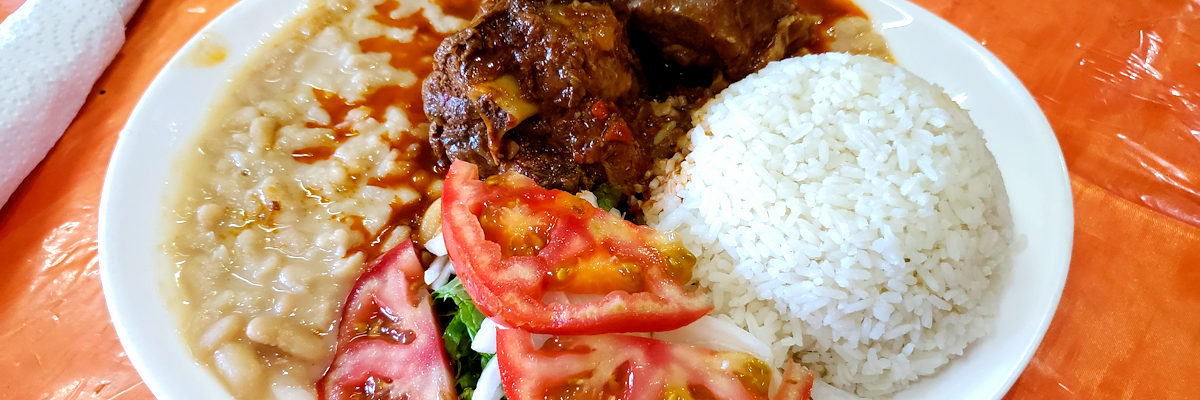
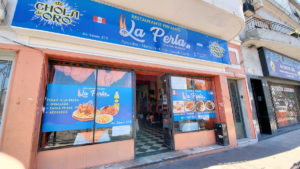
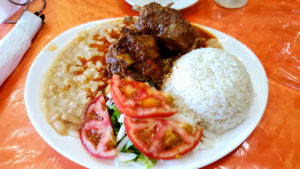
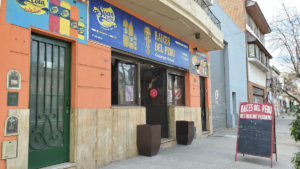
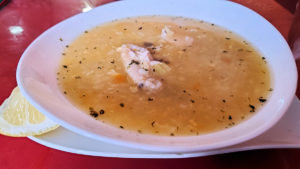
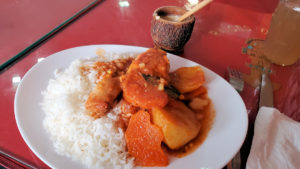
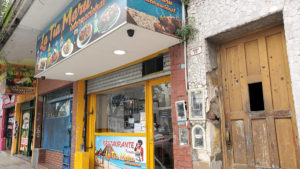
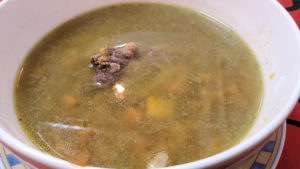
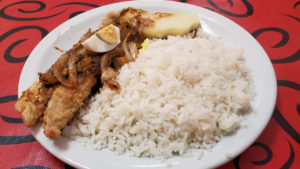
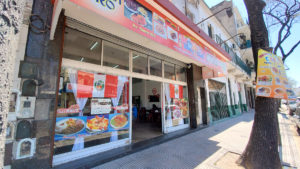
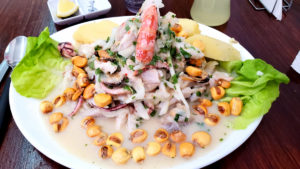
[…] place wasn’t open that last time I was out doing my Saenz of Peruvian Cooking set (1 and 2). I had actually been planning to go to a small cevicheria a half block from here, but it […]